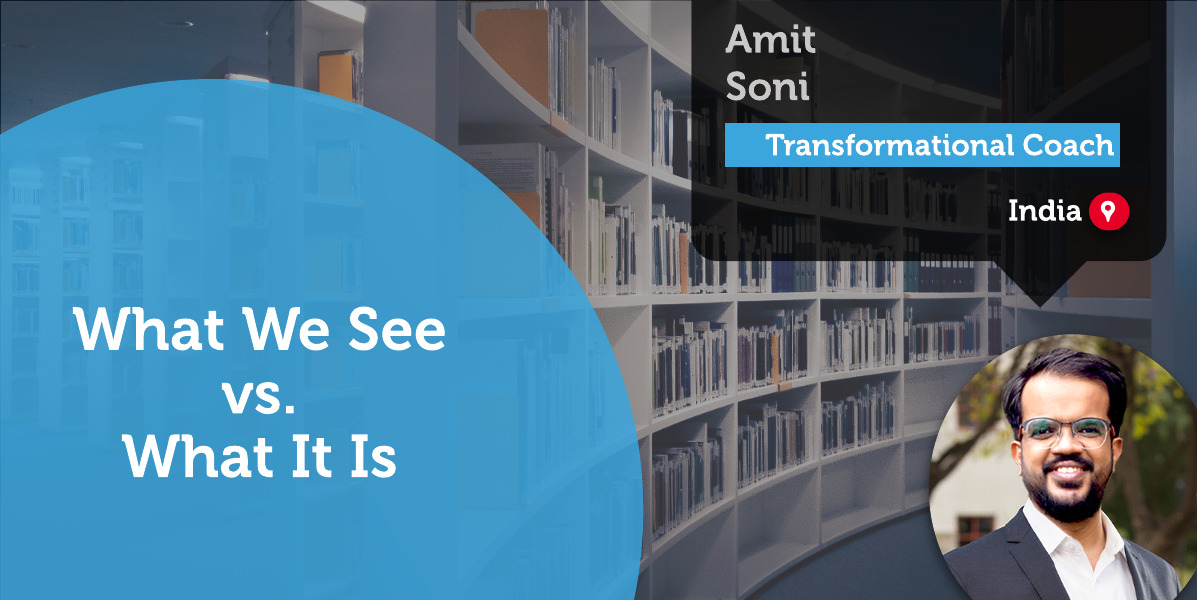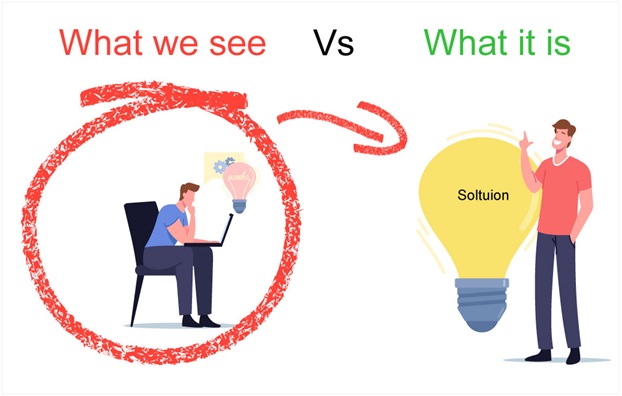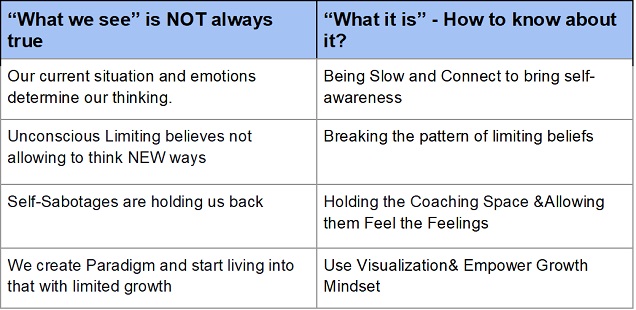A Coaching Power Tool By Amit Soni, Transformational Coach, INDIA


What we see vs. What it is – See Things From a Different Perspective
As a transformational coach, It is imperative to see things from a different perspective. The coach generally has great coaching connect with empathetic listening and holding with the coachee, so the coachee can get self-awareness. Coaching is a beautiful space where a coach can observe and ask powerful questions that can help the coachee see things from a different perspective.
A mind is a potent tool, and we need to be aware of our Mind’s emotions. “Mind your Mind” is a powerful way to see the world from outside to inside. In Vipassana Meditation, they teach how to be aware of your current state without being associated with that. This state is called Equanimous Mind, which means nothing is right and wrong and being observed from outside. This technique is very powerful for self-awareness. It controls everything; if we are not mindful about our thought, it can control our whole life without being aware of what we are into.
“What do You see” is NOT always true
What do you see is the reflection of current thoughts and patterns. With one idea, people will respond in so many ways as we grow up with different experiences in our life, so we develop our perceptions. It is crucial to understand sometimes our perception makes one layer of seeing things from one angle.
There is a beautiful quote, “What you focus on grows,” It is valid for all the ways. It depends upon the coachee’s current circumstances, which define the focus. For example, if someone is working with one goal, the habits and actions will be around to complete that goal. Similarly, unconsciously sometimes we are focused on the situation in the current mindset which can be negative or positive. If things are negative and sometimes focus unconsciously it will grow and make the pattern and we start seeing things from an old perspective. This is called “what you see,” which may be biased with your current emotion. Over time people from certain beliefs about themselves influence their view of what they believe they can achieve. As a result, they:
- Form boundaries around their own inner beliefs.
- Form the limited thinking or sabotages which is holding them back
- Form limiting assumptions about their abilities that relate to their inner beliefs.
- Use inner beliefs as a mental paradigm that controls and regulates their actions, feelings, behaviors, and abilities.
Our Current Situation and Emotions Determine Our Thinking
We are busy human beings with so many distractions, goals, family, work, deadlines, and many activities that arise when we do our day-to-day lives. Multitasking is one of the myths that is becoming true for many people nowadays. Some people go with multiple deliverables and goals simultaneously as it demands the current competitive world. If we continue repeating the same pattern for a long time, our Minds start creating the pattern and habits to do the task accordingly. It creates a comfortable place to do the same thing again and again. While saying that, this can be a problem for many, which may be holding them to grow in their life. We work from one goal to another goal, and based on that, our daily activity also changes. This creates one circle of doing the same thing and bringing the same thinking to the activities.
Coaching agreement is one of the critical elements of coaching. When we start coaching agreement and moving forward with the coachee, sometimes the coachee realizes there is something else that bothers the current situation which may be different from the objective of the coaching session. This is very important during the coaching conversation; when you interact with your coachee, they cannot think beyond one way of Thinking. The coach needs to create awareness with strong coaching connections and bonds.
Unconscious Limiting Believes Not Allowing to Think New Ways
Limiting beliefs are those things you believe about yourself that limit your capabilities. Limiting beliefs are just assumptions about the truth that is not true. For our actions to have the most significant positive effect, we need to have beliefs as close to reality as possible – deceiving ourselves will take us further from the goal. Limiting Belief is like unknown things which hold you to not moving forward. It stops our pattern of thinking new and taking action.
Self-Sabotages Are Holding Us Back
Attaining rewards and bypassing threats are like two sides of a coin. They are not independent systems, and there is a constant interplay in the brain to bring the two drives to an equilibrium. When we balance attaining rewards and avoiding threats, all is well; we feel good about ourselves and ensure our physical and psychological well-being. However, we are primed to self-sabotage when these two desires are out of hit. Self-sabotage occurs when your drive to reduce threats exceeds your drive to attain rewards.
We Create Paradigm and Start Living Into That With Limited Growth
People often function within a paradigm that has worked for them yet is limiting. Limiting because this paradigm was created in the past; beliefs and interpretations developed very early in life, even as early as childhood. Using a system from the past will only provide you with more of the same.
There is no room for an unencumbered future without the willingness to shift perspectives, which means shifting your paradigm. Revealing and relinquishing patterns of Thinking and doing that are outdated and outmoded makes room for fresh and innovative ways of being, doing, and manifesting the life you want.
“What It Is” – How to Know About It?
It is not easy to quickly understand the patterns, beliefs, and seeing things from different perspectives; it requires a stable mind and curiosity to learn and ready to challenge ourselves to move forward. When coaches bring awareness, hold the space, and build trust and empathetic listening during the coaching, They unlock the “ah-ha” moment for coachees. They unlock gremlins, generate new perspectives, awareness, and understanding, and make moving forward possible. Suppose we change the focus from the problem to the solution and see the situation from a helicopter view with a different perspective; it is known as “What it is.” This is the biggest secret of unlocking the “ah-ha” moment and making coaching successful.
Here are elements we need to focus on for helping coachees to see “What it is” during the coaching.
Being Slow and Connect to Bring Self-Awareness
Slowing down is one of the ways to gain more energy and take pauses from the pattern of thinking. We often go on vacation to beautiful places for refreshments. Once we return from the holiday, we feel very energetic because we break the pattern of living the same life activities, seeing the world, and doing something outside our daily activity. Similarly, we can use philosophy during coaching, breaking the thinking pattern with being slow and connecting.
How Can We Become Slow During Coaching?
Breathing is one of the best tools everyone has for free. Take permission from the coachee to allow you to do a breaking activity or Centering activity. Breathing can do wonders in a coachee’s unstable negative emotions. If we can learn how to use it and when to use it, we can master this for any situation. Deep breathing slows your heart rate, allows the body to take in more oxygen, and ultimately signals the brain to wind down. It also balances your hormones- lowering cortisol levels and increasing the body’s endorphin rush. It is unnecessary to do breathing before every coaching starts; However, as a coach, you need to sense the coachee’s emotion and energy and use it any time. When you feel there is an energy shift or think that the coachee cannot help themselves, do the simple breathing technique with them—one of the breathing techniques you can do from the following.
Begin by inviting the coachee to take 3-5 deep breaths through the nose filling the belly, holding for a couple of seconds, and releasing. Do it for 1-2 mins while closing the eyes; if you are doing this virtually, ask your coachee to switch off the camera. It will help the coachee for the coaching session by creating enhanced focus. This leads to heightened awareness, enhancing readiness on the road to self-discovery
Breaking the Pattern of Limiting Beliefs
Breaking the belief pattern may or may not come in one single session. It requires setting and making the coachee connect to feel more psychologically safe to share deep perspectives. The coach will need to challenge, motivate, and help the coachee every coaching step. Coach guides coachee to the place where they can achieve their full potential. The coach will use different techniques to raise the coachee’s awareness of their limiting beliefs. By answering incisive and powerful questions, the coachee will be prompted to see the truth first. Once the coach indicates the coachee’s limiting beliefs, they can help them address and change them.
If the coachee cannot see a way forward or think of what to do to progress towards achieving their goal, you can use well-phrased, powerful questions that raise the perception and open the realms of possibility. These questions usually have two parts to them. The first part is the temporary suspension of the limiting belief, which then allows the coachee, for a moment, to be creative as they answer the second part. It frees the logical Mind to explore outside the limitations it has imposed. This technique is very successful as it clears a coachee’s Mind.
Holding the Coaching Space
“Coaching Space is where we as coaches pause and give coachees time to reflect and have self-talk to get deeper. Holding space helps the coachee see something worthwhile for them to learn, is confident of their ability to learn, trusts their Coach, and grants them the authority to be their supporter. Until these elements are in place, the Coach will push uphill to engage with their coachee successfully. Coaching space allows the coaches some time. Sometimes we can use the space a little longer – allow the coachee to think more.
Being aware of your emotion and feeling can change your perspective. Asking the right question, which helps reflect the current emotion, can be very helpful to generate the awareness of understanding their true feelings and emotions. Sometimes, that might include feelings of joy, but you do not want to try to force happy thoughts or resist any emotional response. Sometimes, the coachee needs to accept unpleasant emotions as a moment. Accept disappointment, sadness, anger, jealousy, etc., as what they are and allow themselves to feel them. As a coach and courageous, we need to be mindful of how we react to coachees’ feelings, but it is healthy to acknowledge them for what they are. When coachees can shift from a state of apprehension to stability, they will see their situation more clearly. They will gain confidence in their ability to handle whatever they are dealing with. They will have a more balanced view of their circumstances and deal with them.
Use Visualization & Empower Growth Mindset
Visualization is an effective technique as it gives a broader picture to the coachee to see the situation as a picture. One could suggest that by using the method of visualization in coaching, one could create a new journey for themselves. Using this powerful concept, a coach can ask powerful questions that help coachees see what they want to be.
With a Growth Mindset, Your coachee needs to move forward with the current emotion and get to the next level of success. Coaching Moving Forward Strategies will clarify how you can unlock emotion and think for the solution. Each person is unique in their desires, and with our asking the right questions, coachees can empower to get the solutions.
Set of practical questions for bringing coachee from “What you see” to “What it is” approach
- What is the motivation for bringing this up?
- How do you feel about it?
- Describe the feeling of how it physically FEELS).
- What is your feeling is trying to tell you?
- What are you learning about yourself?
- What is there you are not saying?
What We See vs. What It Is Explanation

What We See vs. What It Is Useful Coaching Tool
While What we see vs. What it is. a power tool is a useful coaching tool; it is important to create trust and connection first with the coachee and then introduce this powerful tool. However, as a coach, we cannot apply this tool to all the coachee’s same way. Each coachee has different beliefs and personalities, so using this more personalized depends on the coachee and situation during coaching. When we talk about creating the way we need to move forward in the coachee’s way, allow coachees to experience that “what it is” by experiencing themselves in their way. Allow some space and create an environment where coachees feel comfortable. Look for moments and get comfortable asking big, open-ended questions that genuinely allow your employees to generate their most motivating next steps.